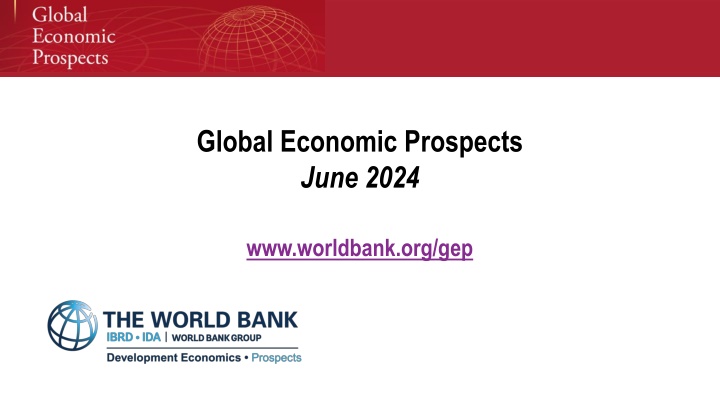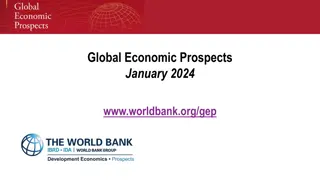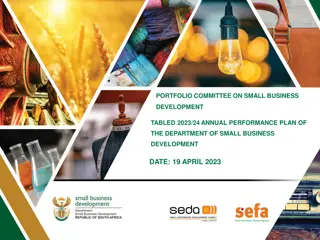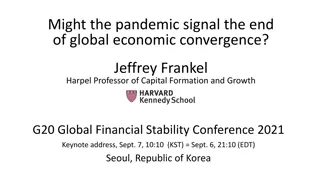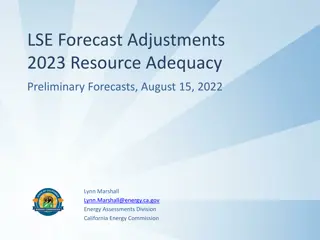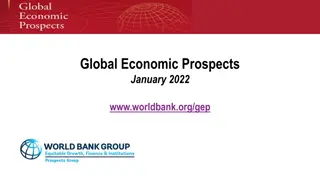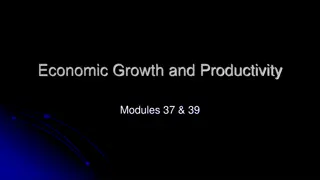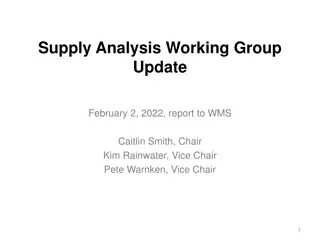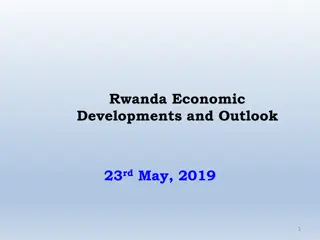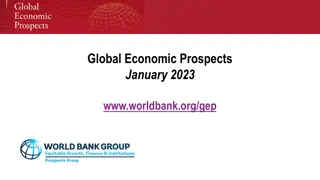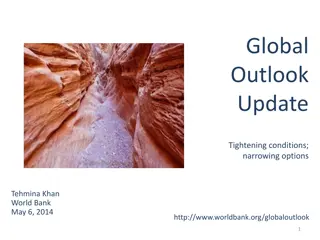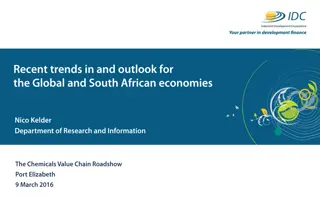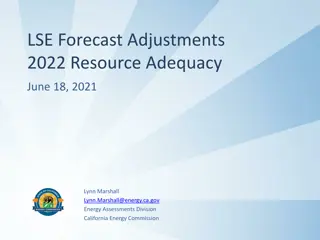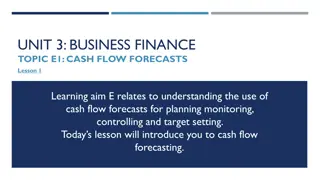Global Economic Prospects June 2024 - Growth Forecasts and Risks
Providing insights into the global economic outlook for June 2024, including growth forecasts, risks, inflation scenarios, and interest rates. The report covers factors influencing global growth, such as geopolitical tensions, trade fragmentation, and policy uncertainties.
Download Presentation

Please find below an Image/Link to download the presentation.
The content on the website is provided AS IS for your information and personal use only. It may not be sold, licensed, or shared on other websites without obtaining consent from the author.If you encounter any issues during the download, it is possible that the publisher has removed the file from their server.
You are allowed to download the files provided on this website for personal or commercial use, subject to the condition that they are used lawfully. All files are the property of their respective owners.
The content on the website is provided AS IS for your information and personal use only. It may not be sold, licensed, or shared on other websites without obtaining consent from the author.
E N D
Presentation Transcript
Global Economic Prospects June 2024 www.worldbank.org/gep
Global Economic Prospects June 2024 Underlying data and charts can be found at www.worldbank.org/gep 3
Global Growth Forecasts Broadly Stable Near-Term Growth; Weaker Than the 2010s Average 4
Growth and Income Catch-Up Shifting Growth Distribution; Broad-Based Weakness; Few EMDEs Catching Up Contributions to global growth (Percentage points) United States China Other EMDEs Per capita income in EMDEs (Percent; relative to advanced economies) Lower GDP growth in 2024-25 than 2010-19 (Percent of world total in 2024-25) 100 (Percent) 4 4 14 Euro area Other AEs World (RHS) EMDEs EMDEs excl. China and India 75 3 3 12 50 2 2 10 25 1 1 8 0 0 0 Economies GDP Population 6 2010-19 average 2024 2025 2000 2005 2010 2015 2020 2025 Share of world total Sources:UNWorldPopulationProspects;WorldBank. Note:AEs = advanced economies. GDP aggregates are calculated using real U.S. dollar GDP weights at average 2010-19 prices andmarket exchangerates. GDP per capita aggregates are calculated as aggregated GDP divided by the aggregate population. Data for 2024 are estimates, and data for 2025 are forecasts. Left Panel. Contributions to global growth by respective economies (in percentage points). Center Panel. Economies refersto the shareof countries, GDP the shareof world GDP, and population the shareofthe worldpopulation. Right Panel.Per capita income in EMDEs as apercentage of theper capita incomein advanced economies. www.worldbank.org/gep 5
Risks to the Global Outlook Downside Risks Dominate But Presence of Some Upside Risks Geopolitical tensions and armed conflicts Further trade fragmentation Heightened policy uncertainty Weaker-than- expected long-term growth More frequent natural disasters Higher-for-longer interest rates Faster monetary easing with lower inflation Stronger-than- expected growth in the United States 6
Global Inflation, Interest Rates, and Growth Scenarios Slower Disinflation; Elevated Interest Rates; Negative Impact of Higher for Longer on Growth Global inflation forecast (Percent) Inflation targets January 2024 June 2024 Monetary policy rates in AEs (Percent) 1990-2019 average Higher-for-longer scenario Growth in higher-for-longer scenario (Percentage points; deviation from baseline) 0.0 10 8 8 -0.1 6 90 percent confidence interval 6 -0.2 4 4 -0.3 2 2 -0.4 2024 2025 2024 2025 2024 2025 0 0 World Advanced economies EMDEs 2019 2022 2024 2026 1990-99 2000-09 2010-19 2025-26 Sources:Bloomberg;ConsensusEconomics;HaverAnalytics;OxfordEconomics;WorldBank. Note:AEs=advanced economies.Left Panel.Model-based GDP-weightedprojectionsof consumer price inflation usingOxford Economics GlobalEconomicModel. Sample includes65 countries, including31 EMDEs. Confidence bands are derived from Consensus Economics forecast errors using thepre-pandemic sample. Center Panel. Average annualpolicy interest rates. Aggregates are calculated as GDP-weighted averages of the policy rates and policy rate expectations (for 2025-26) for the United States, the euro area,andthe United Kingdom.Policy rate expectations are based on futures curves observedon May 31,2024. Diamond showsthe expected policy rate under the higher-for-longer policy rates scenario. Right Panel. Deviation in global growth under the higher-for-longer scenario relative to the baseline. Scenarios are produced using the Oxford Economics GlobalEconomicModel.www.worldbank.org/gep 7
Investment Needs, Impact of Public Investment on Growth Slower Public Investment Growth Despite Large Needs and Positive Impacts Public investment growth (Percent, annual average) 1990-2022 average Impact of increase in public investment (Percent; cumulative after four years) 1.5 Investment needs for climate resilience (Percent of GDP, per year) 9 15 3 *** ** 10 6 1.0 2 * 5 3 0.5 1 0 2000-09 2010-22 2000-09 2010-22 2000-09 2010-22 0 0.0 0 Low Lower middle Upper middle EMDEs EMDEs excl. China World Output TFP Private investment (RHS) Income group Sources:Haver Analytics;IMFInvestmentandCapitalStock Dataset;WDI(database);WorldBank. Note:TFP =total factor productivity. Left Panel. Estimatesof the annual investment needs to build resilienceto climate change and put countries on track to reduce emissions by 70 percent by 2050. Depending on data availability, estimateshttp://www.worldbank.org/gep include investment needs for transport, energy, water, urban adaptations, industry, and landscape. CenterPanel.Public investment refers to general government gross fixed capital formation. Sample includes up to 162 economies, of which 126 are EMDEs. Average annual public investment growth calculated with countries real public investment in constant international dollars as weights. Right Panel. Responseof real GDP,TFP, andrealprivate investment (cumulative change in year t = 4 relativeto year t =-1, in percent) to a public investment shock equivalent to onepercent of GDP;t =0 isthe year of theshock.***, **, * indicatestatisticalsignificanceat1,5,and10 percentlevels, respectively.Sampleincludesup to 129 EMDEs. www.worldbank.org/gep 8
Public Investment: Role of Fiscal Space and Investment Efficiency Greater Growth Impact with Wider Fiscal Space and Higher Public Investment Efficiency Efficiency and management (Index, 0-100 [best]) (Index, 0-4 [best]) Public investment and interest payments (Percent of GDP; 2010s) 20 Impact of public investment on output (Percent; cumulative after four years) 90 2 4 Max (RHS) Advanced economies *** *** 15 60 3 1 10 30 2 5 0 0 1 Wide Narrow High Low EMDEs* LICs EMDEs* LICs (Percent of GDP) 0 Fiscal space Public investment efficiency Public Public investment management index (RHS) -2 0 Net interest payment 2 4 6 8 infrastructure efficiency index Sources:Dabla-Norriset al. (2012);InternationalMonetary Fund;WorldBank. Note:EMDEs* = EMDEs excl. low-incomecountries (LICs).Left Panel.Response of real GDP (cumulative change in year t = 4 relativeto year t =-1, in percent) to apublic investment shock equivalent to one percent of GDP, based on local projections. *** indicates statistical significance at the1 percent level.Wide andnarrow fiscal space state corresponds to historically lowest and highest debt ratios for a given country in public investment shock years. High and low efficiency corresponds to thetop and bottom quartiles of the IMF s public infrastructure efficiency index. Center Panel. Relationship between public investment and net interest payments, computed as differences between primary balances and fiscal balances(in percent of GDP) in EMDEs. Right Panel. Blue bars showgroup mediansof theIMF public infrastructure efficiency index. Red bars showgroup mediansof theDabla-Norrisetal.(2012)publicinvestmentmanagementindex.www.worldbank.org/gep 9
Fiscal Positions in Small States More in Debt Distress amid Weaker Primary Balances; Larger Costs of Natural Disasters Risk of debt distress (Percent of countries) Weaker primary balance, 2020-23 (Percent of countries; relative to 2015-19) Natural disasters: cost and frequency (Percent of GDP) 24 Average cost Frequency (RHS) (Frequency) 80 80 8 In debt distress High risk Moderate risk Low risk 60 18 6 70 40 12 4 20 60 6 2 0 0 0 2015 2023 2015 2023 Small states EAP small states LAC small states EMDEs excl. small states 50 Small states EMDEs excl. small states Small states EMDEs excl. small states Sources:EM-DAT (database);InternationalMonetary Fund;WEO(database);WorldBank. Note:EAP = East Asia and Pacific; LAC = Latin America andthe Caribbean. Left Panel.Percent of small states and other EMDEs in overall debt distress or at risk of debt distress, based on the published Joint World Bank-IMF Debt Sustainability Framework for Low Income Countries (LIC-DSF) as of March 30, 2024. Center Panel.Percent of countries with weaker average primary balances as a shareof GDP in 2020-23 than in 2015-19. Sample includes32 smallstatesand110 other EMDEs. RightPanel. Frequency istheaveragenumber of natural disastersper year, adjusted by land mass.Unit of frequency isthenumberof natural disastersper year per onehundredthousandsquarekilometers. Averagecostofnaturaldisastersperyear aspercentof GDP for 24smallstatesand93 otherEMDEs.Sampleperiodfrom 2000-22.www.worldbank.org/gep 10
Revenue and Expenditure Challenges in Small States Greater Reliance on Non-Tax Revenues; Spending Inefficiency; Gaps in Fiscal Frameworks Composition of total revenues (Percent; 2011-22) Expenditure efficiency (Index, 0-1 [highest]; 2010-20) Countries with fiscal frameworks (Percent of countries) Small states EMDEs excl. small states 100 1.0 60 0.8 75 40 0.6 50 0.4 25 20 0.2 0 Small states EMDEs excl. small states Grants 0 0.0 Fiscal rule Fiscal council Tax Other Education Health Investment Sources: GFS(database); Herrera et al. (forthcoming); International Monetary Fund;WDI (database); World Bank. Left Panel. Average composition of total revenue by major component in 34 small states and 97 other EMDEs over the period 2011 to 2022. Center Panel. Average efficiency score for up to five different methodologies for 35 small states for health, 6 small states for education, and 8 small states for infrastructure investment over 2010-20 from Herrera et al. (forthcoming). Sample includes up to111 other EMDEs.Right Panel. Percent of countries that have fiscal rules or fiscal councils as of year 2021. www.worldbank.org/gep 11
Trade Policy Weakest Half-Decade Growth; MoreTrade Distortions; Higher Trade Policy Uncertainty 12
